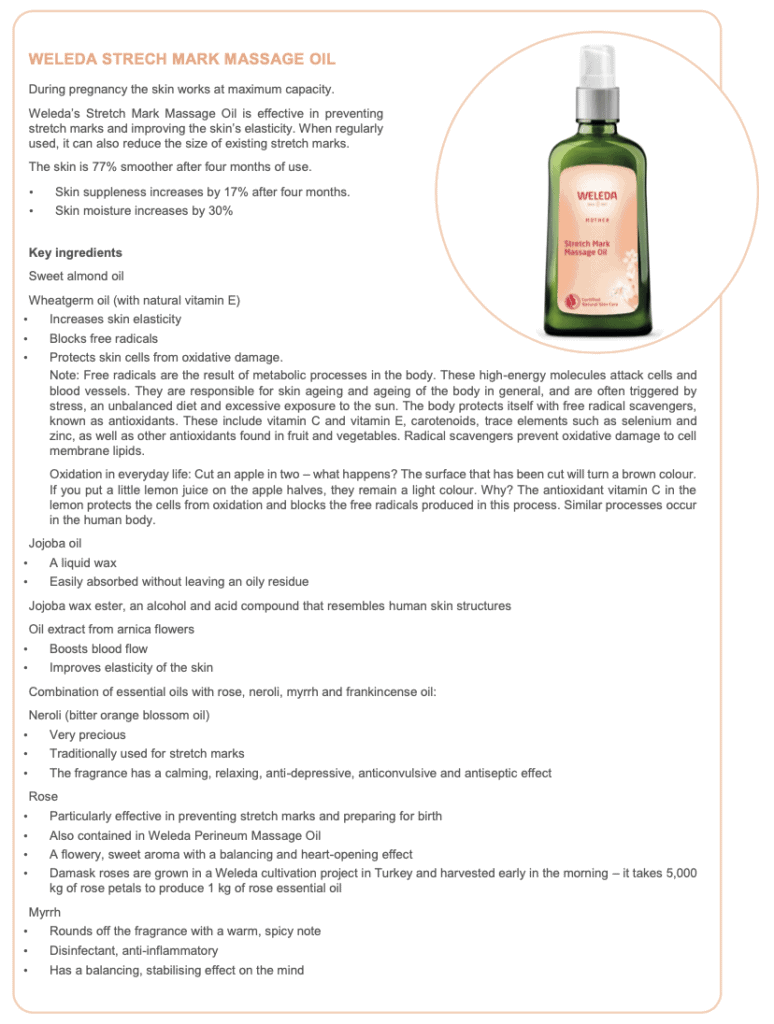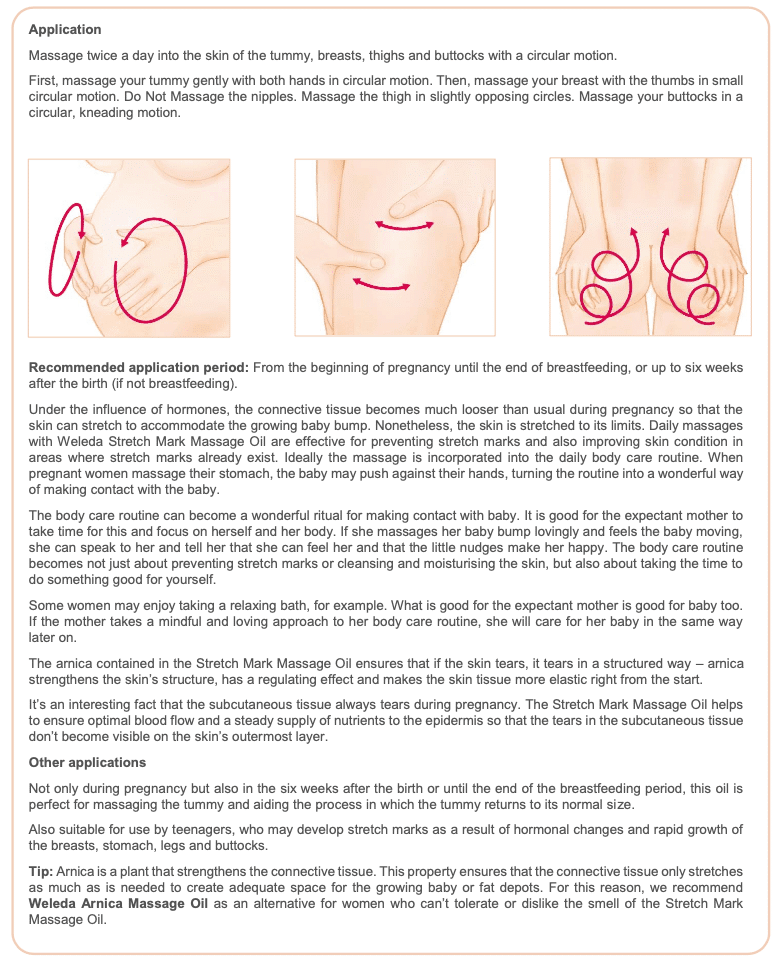Stretch marks in pregnancy
Hannah Tizard
Research Midwife Blackpool Teaching Hospitals NHS Foundation Trust, Editor-in-Chief The Student Midwife Journal, Project Lead All4Birth and Founder BloodtoBbay.com
@midwifetiz
How do stretch marks develop?
 The skin works hard during pregnancy, stretching to give the baby space in the belly.
The skin works hard during pregnancy, stretching to give the baby space in the belly.
Stretch marks usually first appear around the sixth and seventh month of pregnancy1 but have been reported prior to 24 weeks gestation.2 Stretch marks affect 50% to 90% of women.3 Though not a health issue they can affect women in different ways, for example, cause stress or be an aesthetic or cosmetic concern.4
The epidermis of the skin grows along with the baby and the mother’s fat deposits, which are gradually forming as well. Various hormones prepare the dermis – the layer of skin where the connective tissue is located – so that it can stretch more easily. When the dermis can no longer stretch any further, it tears as much as necessary to give the body enough space. During pregnancy these tears are visible as red “stripes”. After a few months they grow paler and are visible as thin white stripes – scars under the skin.
The exact nature of why women get stretch marks is not yet well understood.
The three main theories relating to stretch mark formation5 are:
- Mechanical stretching of the skin; skin structure
- Hormonal changes in pregnancy
- Genetic predisposition; family history of stretch marks
Other factors possibly causing women to be more likely to get stretch marks include; women who are taking steroid medications or using topical steroid creams, being a younger mum, higher pre-pregnancy body mass index (BMI), higher weight gain during pregnancy, higher birth weight and longer pregnancies, multiple pregnancies or increased amniotic fluid.6 However, these factors haven’t been clearly proven and in fact, women with a higher BMI, for example, often don’t suffer with many stretch marks at all. In severe cases, stretch marks may lead to itchiness and restlessness in the pregnant woman.2
Can stretch marks be prevented using topical treatments (creams)?
A Cochrane Review in 20123 evaluated six topical creams via six trials involving a total of 800 women, the review found no high-quality evidence to support the use of topical preparations for the prevention of stretch marks during pregnancy.
The authors recommended that preparations commonly used by women to prevent and treat stretch marks should be evaluated in large trials. Since then, numerous other studies have been conducted, though the outcomes on standard treatment, prevention or improvement of stretch marks are varied.
Some studies have discussed that collagens, elastin, and fibronectin is decreased in stretch mark tissue, demonstrating a possible link between the overall loss of elastic fibres in skin affecting stretch mark occurance.7,8 Theories suggest that skin’s elasticity can be enhanced through the use of topical preparations at early stages or prior to pregnancy which may later reduce the appearance and depth of the tears.9 The tearing of the skin cannot be prevented using topical treatments.
No one solution has been shown to work for everyone, but some women report to find success with regular use of creams and massages of the skin at particular sites, like the stomach area, the breasts and the buttocks which may help the skin to become more elastic.6 It is beneficial to start this regime prior to stretch marks appearing.10,11
Tips for preventing stretch marks
The skin’s elasticity may be maintained or improved by applying specially formulated creams and massaging the stomach area, breasts and fat depot areas during pregnancy.6 The Weleda Stretch Mark Massage Oil is specially formulated with highly effective plant extracts to improve the skin’s elasticity and suppleness. It contains vitamin E-rich wheat germ oil and extracts of arnica and jojoba oil.

Weleda suggest massaging the skin once or twice a day with the Stretch Mark Massage Oil which helps to strengthen the connective tissue and improve the appearance of stretch marks whilst also aiding comfort measures.

Other tips include using good sun protection, this does not prevent stretch marks but can improve the overall health of your skin. Sun exposure can break down the skin collegen fibres possibly contributing to your chance of getting stretch marks.12
Exercise improves circulation and prevents inflammation. Exercising regularly strengthens the connective tissue, which can help to prevent stretch marks but certainly won’t make them go away.13
Like the massages, contrast showers with hot and cold water increase blood flow.
A healthy diet with plenty of fresh fruit, vegetables and liquids (water or juices diluted with water) will also ensure that the skin has an optimal supply of nutrients.
Medical products like Tretinoin often called by its brand name Retin-A, can cause side effects, such as redness and peeling. Pregnant or breastfeeding women should not use this drug.1
Summary
Whether pregnant or not, the majority of men and women will get stretch marks at some point in their life. Particularly, stretch marks are associated as a positive sign of being a woman, bringing a life into the world. That said, one of the motivations for the continued preparation of many topical treatments to reduce and alleviate the perceived undesirable effects of stretch marks is due to demand from women as many have concerns about the way stretch marks appear on the body. There are other expensive methods for improvement of stretch marks, such as laser treatment which can be considered after pregnancy, however at present acceptance of your stripes and using topical treatment for comfort is probably the most empowering method of dealing with them.
References
- McKenzie A. SKIN DISORDERS IN PREGNANCY. Obstet Gynecol Surv. 1972;27(1):22-24. doi:10.1097/00006254-197201000-00006
- Chang A, Agredano Y, Kimball A. Risk factors associated with striae gravidarum. J Am Acad Dermatol. 2004;51(6):881-885. doi:10.1016/j.jaad.2004.05.030
- Brennan M, Young G, Devane D. Topical preparations for preventing stretch marks in pregnancy. Cochrane Database of Systematic Reviews. 2012. doi:10.1002/14651858.cd000066.pub2
- Brennan M, Clarke M, Newell J, Devane D. Prevention of striae gravidarum: study protocol for a pilot randomised controlled trial. Trials. 2018;19(1). doi:10.1186/s13063-018-2898-7
- Giuliani M, Orsini G, Romano L, Cifone M. Skin Laxity and Striae Distansae: a mini-review. Aesthetic Medicine. 2016;2(2). http://wwww.aaaam.pl/upload/201905/AE_2_2016.pdf#page=35. Accessed April 18, 2020.
- Bogdan C, Iurian S, Tomuta I, Maldovan M. Improvement of skin condition in striae distensae: development, characterization and clinical efficacy of a cosmetic product containing Punica granatum seed oil and Croton lechleri resin extract. Drug Design Development and Therapy. 2017;11. doi:10.2147%2FDDDT.S128470
- Ostovari N, Saadat N, Nasiri S, Moravvej H, Toossi P. The 308-nm excimer laser in the darkening of the white lines of striae alba. Journal of Dermatological Treatment. 2010;21(4):229-231. doi:10.3109/09546631003592044
- Tung J, Kiefer A, Mullins M, Francke U, Eriksson N. Genome-Wide Association Analysis Implicates Elastic Microfibrils in the Development of Nonsyndromic Striae Distensae. Journal of Investigative Dermatology. 2013;133(11):2628-2631. doi:10.1038/jid.2013.196
- Wang K, Ross N, Osley K, Sahu J, Saedi N. Evaluation of a 1540-nm and a 1410-nm Nonablative Fractionated Laser for the Treatment of Striae. Dermatologic Surgery. 2016;42(2):225-231. doi:10.1097/dss.0000000000000629
- Elsaie M, Baumann L, Elsaaiee L. Striae Distensae (Stretch Marks) and Different Modalities of Therapy. Dermatologic Surgery. 2009;35(4):563-573. doi:10.1111/j.1524-4725.2009.01094.x
- Wollina U, Goldman A. Management of stretch marks (with a focus on striae rubrae). J Cutan Aesthet Surg. 2017;10(3):124. doi:10.4103/jcas.jcas_118_17
- Schwartz E, Cruickshank F, Christensen C, Perlish J, Lebwohl M. COLLAGEN ALTERATIONS IN CHRONICALLY SUN-DAMAGED HUMAN SKIN. Photochem Photobiol. 1993;58(6):841-844. doi:10.1111/j.1751-1097.1993.tb04981.x
- Boldt A. Does Exercise Make Stretch Marks Go Away? | Livestrong.com. LIVESTRONG.COM. https://www.livestrong.com/article/383935-does-exercise-make-stretch-marks-go-away/. Published 2020. Accessed April 18, 2020.
- Ud-Din S, McGeorge D, Bayat A. Topical management of striae distensae (stretch marks): prevention and therapy of striae rubrae and albae. Journal of the European Academy of Dermatology and Venereology. 2015;30(2):211-222. doi:10.1111/jdv.13223








